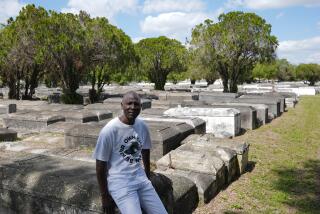Sylvia Plath’s Tombstone in England Defaced, Removed : 25 Years After Her Suicide, Tormented American Poet Finds No Peace
- Share via
HEPTONSTALL, England — First her married name was chiseled off her tombstone three times. Later the stone vanished, and so did its replacement.
Even in death, Sylvia Plath is not at peace.
The admired American poet lies in an unmarked grave high in the Yorkshire hills, a bleak resting place for a tormented soul who killed herself when she was 30.
Nobody knows who is tampering with her grave, but some suspect feminist activists of erasing “Hughes” from the stone in the belief that Plath’s marriage to British poet Ted Hughes contributed to her misery by turning her into a housewife.
Plath’s reputation has grown since her suicide in 1963. “The Bell Jar,” her semi-autobiographical novel, has sold 200,000 copies in Britain. She posthumously won the 1982 Pulitzer Prize for her “Collected Poems.”
Her grave in Heptonstall, a clutch of stone houses in the austere south Pennine hills, has become a place of pilgrimage. A little rosebush grows on it, and some modest wreaths and cut flowers lie about. Crows and magpies fly above.
A large granite tombstone once stood on the grave, inscribed, “In Memory. Sylvia Plath Hughes. 1932-1963.”
Below were two lines of poetry:
“Even amidst fierce flames
The golden lotus can be planted.”
Estranged From Hughes
They were written by Hughes, now Britain’s Poet Laureate. He was estranged from his wife when she gassed herself in their London apartment Feb. 11, 1963.
In February, 1987, residents say that two women were seen picking the lead letters of the Hughes name off the tombstone. They said the name had been removed twice before.
The stone then disappeared.
“We get visitors from all over the world to see the grave, and they come in to say they can’t find it. It seems a shame,” said Judith Parish, who runs the newspaper shop.
“I think feminists interfered with the inscription because they object to the addition of Hughes’ name to Sylvia’s,” said Elaine Connell, a local teacher.
“Some people think Hughes was somehow to blame in his wife’s death because he left her to cope with the children,” Connell said. She said that a local newspaper had reported that the tombstone was removed for restoration.
“But that was hardly true as only the one name had been picked off, and the tombstone was never returned,” she said.
The question of feminist involvement was raised again after the publication this year of “Sylvia Plath,” a biography by Linda Wagner-Martin, professor of English at Michigan State University.
Hughes, 57, was reportedly furious with Wagner-Martin for writing that he left his wife to do the housework and raise the couple’s two children while he pursued his career.
Hughes was recognized as a fine poet when he married Plath after they met in 1956 at Cambridge University, and critics say his influence deepened his wife’s poetic creativity.
Hughes, who remarried 18 years ago, never talks to the media. His sister, Olwyn, who sometimes speaks for him, did not return phone calls.
The Sunday Times of London reported in March that Hughes sent it a 15-page rebuttal of Wagner-Martin’s book after reading an early draft of it.
Hughes conceded that Plath may have resented his “comparative freedom” but insisted that to suggest she was jealous of his poetic ability would be “a major misjudgment of her character,” the paper said.
Wagner-Martin said she felt that Hughes was not sensitive enough to his wife’s needs in the last months of their marriage.
“I saw her daily calendar of the things she had to do, like mowing, cooking and shopping, and there was no suggestion that Ted was going to help with them,” Wagner-Martin said.
However, critic Frank Kermode, reviewing the biography in London’s Sunday Telegraph, wrote: “Surely the enemies she had to deal with weren’t housewifely duties and the selfishness of men, but interior demons much more terrible.”
Plath’s best-known poems dealt with illness, suffering and death--she had already survived a suicide attempt at age 20.
She is buried near Hughes’ parents outside the churchyard wall of St. Thomas the Apostle.
“I was told that it took some pressure to get a tombstone, and it was only put on her grave five or six years after the burial,” Wagner-Martin said. “I have no idea who interfered with the stone and the grave, but I am sure it is not the people of Yorkshire.”
Villager Ronald Eveleigh, 76, a retired engineer and admirer of Plath’s poetry, said he made a border of little stones around the grave when the tombstone disappeared.
“I also got larger stones and scratched or painted the name of Sylvia Plath on them so the grave could be identified by visitors, but those were taken away, eight times altogether,” he said.
Eveleigh’s wife, Evelyn, said she tried to discover who was responsible for the grave.
“I couldn’t find out, and it seemed the church authorities were being evasive,” she said. “I presume it’s up to Ted Hughes.”
More to Read
Sign up for our Book Club newsletter
Get the latest news, events and more from the Los Angeles Times Book Club, and help us get L.A. reading and talking.
You may occasionally receive promotional content from the Los Angeles Times.










